
A variety of electrical and electronic devices are used by engineering students to prepare their projects. The components used in this project are active and passive sensors, transducers, transmitters, receivers, modules, etc. Energy is usually converted from one form to another in the process of power transfer.
This process involves a sensory element that senses the input energy. And then converting it to another form by the transduction element. Measurand tells the property, quantity, or state that the transducer looks to translate into electrical output. In today’s article, we will see what are transducers, how many types of transducers and what are the applications of transducers.
What is Transducer?
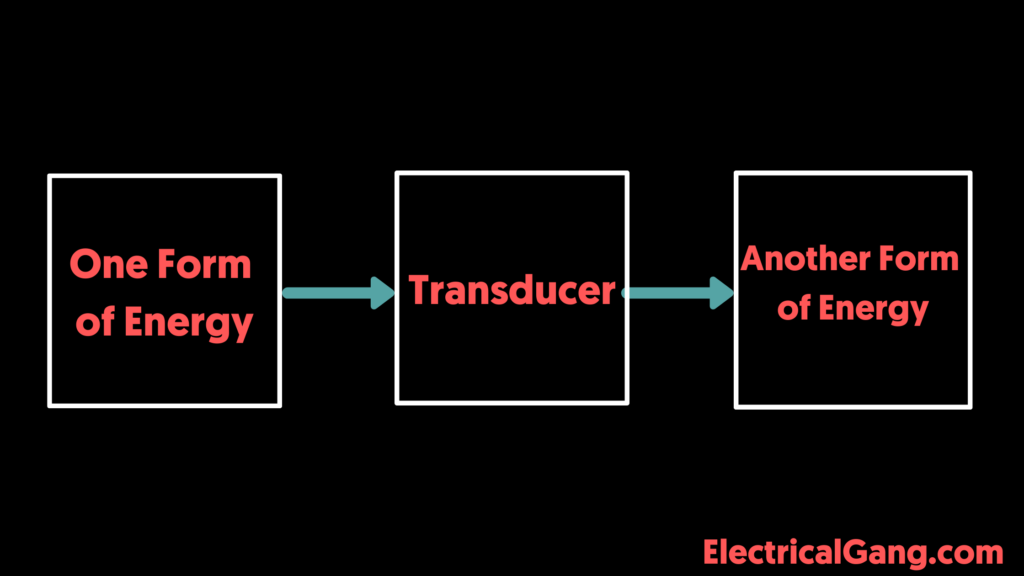
A transducer is an electric device that converts one form of energy into another. Mainly this device works easily with different types of energy like mechanical energy, electrical energy, chemical energy, thermal energy, light energy, acoustic energy, and electromagnetic energy.
For example, we use mobile in our daily life. In a mobile phone, it works by converting sound into an electric wave and then amplifying it into the desired range. The loudspeaker then converts the electrical signal from the output into an audio signal. In today’s modern life fluorescent bulbs are used for lighting. Which converts electrical energy into light energy.
An excellent example of a transducer is a loudspeaker, microphone, position, thermometer, antenna, and pressure sensor. This is how different types of transducers are used in electronic and electric projects.
Suggested Read: What is a MOSFET | Construction Of MOSFET | Working Principle Of MOSFET
Types of Transducer Based on Quantity to Be Measured:
The types of transducers are as follows depending on the quantity to be measured.
| Sr. No. | Types of Transducer Based on Quantity to Be Measured |
| #1. | Temperature transducers |
| #2. | Pressure transducers |
| #3. | Oscillator transducer |
| #4. | Displacement transducers |
| #5. | Flow transducers |
| #6. | Inductive Transducer |
Types of Transducer Based on the Principle of Operation:
The types of transducers based on the principle of operation are as follows:
| Sr. No. | Types of Transducer Based on the Principle of Operation |
| #1. | Photovoltaic |
| #2. | Chemical |
| #3. | Mutual induction |
| #4. | Electromagnetic |
| #5. | Piezoelectric transducer |
| #6. | Photoconductors |
| #7. | Hall effect |
Suggested Read: How to Fix Hulu Streaming Problems in Minutes
Conditions for Transducer Types:
The transducer can be rated subject to certain conditions which are discussed below:
#1. Dynamic Range:
The working range of the transducer is the ratio between the signal of high vibration area and the signal of low vibration area. So that the transducer can translate easily. It is more precise and sensitive when the time transducer has a high dynamic range.
#2. Repeatability:
Repetition is the ability of the transducer to produce a uniform output after being stimulated by means of a single input.
#3. Noise:
Adds some random noise through the output of the transducer. The noise added by this to the electrical type transducer can be electrical. As the thermal action of the charge in the circuit. Smaller signals can be contaminated with more noise than larger signals.
#4. Hysteresis:
The output of the transducer under this property does not depend only on its input. However, it depends on its previous input. For example, an actuator uses a gear train that has a bit too much reaction. The time the direction of the equator changes. Then there will be a dead zone between the teeth of the gear before the output of the actuator is reversed by the game.
Suggested Read: What is an Electrical Transducer? | A Complete Guide
Types of Transducer and Applications of Transducer:
There are different types of transducers available in the market such as pressure transducers, ultrasonic transducers, piezoelectric transducers, temperature transducers, etc. Let us discuss the various transducers used in practice.
Some transducer types, such as active transducers and passive transducers, depend on whether a power source is required.
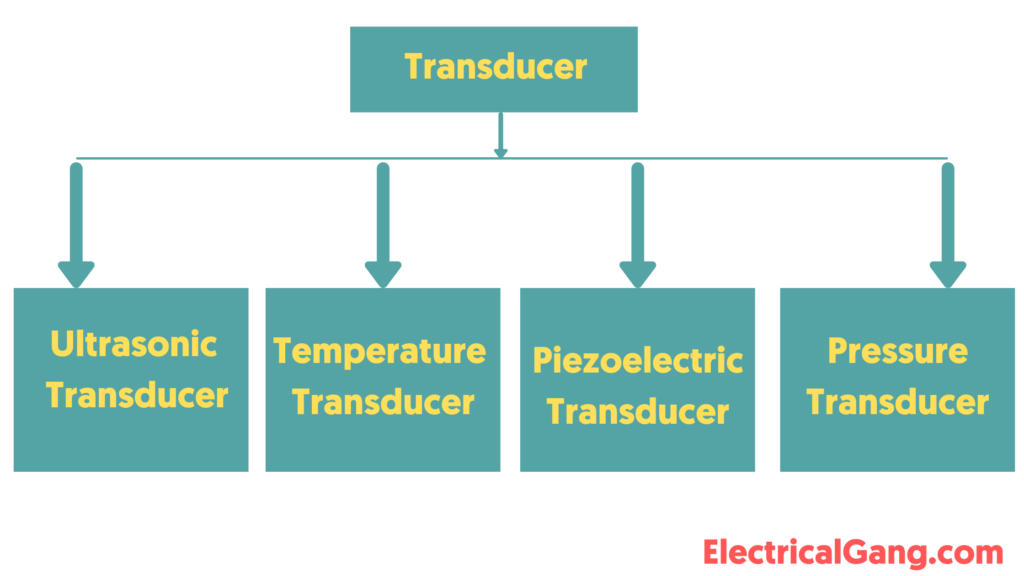
An active transducer does not require any type of power source. This transducer works on the principle of energy conversion. It generates electrical signals that are input. The best example of such a transducer is a thermocouple.
Conversely, a passive transducer requires an external power source for operation. It gives the output in the form of capacitance resistance. It must then be converted to a voltage or current signal. An excellent example of a passive transducer is a photocell.
#1. Ultrasonic Transducer:
The main function of an ultrasonic transducer is to convert the electrical signal into ultrasound waves. Another name for this transducer is also known as a capacitive or piezoelectric transducer.

Application of Ultrasonic Transducer:
This transducer is used to measure the distance of sound based on the reflection. This measurement depends directly on the appropriate method compared to the methods. Which uses different size scales. Areas that are difficult to find such as pressure areas, and very high temperatures, thus measuring distances using conventional methods is not an easy task. Therefore this transducer-based measurement system can be used in such types of zones.
This transducer uses 8051 microcontrollers, a power supply, and an ultrasonic transducer module. Including transmitter and receiver. LCD display blocks are used.
If any kind of obstruction or object is found here, it can be detected by the ultrasonic transducer. These waves are transmitted and the waves that are reflected from the object are received by these transducers. The time taken by the transducer to transmit and receive the waves can be recorded considering the speed of sound.
The distance is then measured and displayed on the LCD display, depending on the speed of sound and the pre-programmed microcontroller. Here, the display is interfaced with a microcontroller. The ultrasonic transducer generates 40kHz frequency waves.
#2. Temperature Transducer:
A temperature transducer is an electrical device used to convert the temperature of a device into electrical energy or pressure energy or mechanical energy. The quantity control device will then be sent to control the temperature of the device.
Application of Temperature Transducer:
A temperature transducer is used to measure air temperature. To control the temperature of many control systems such as air conditioning, heating ventilation, etc.
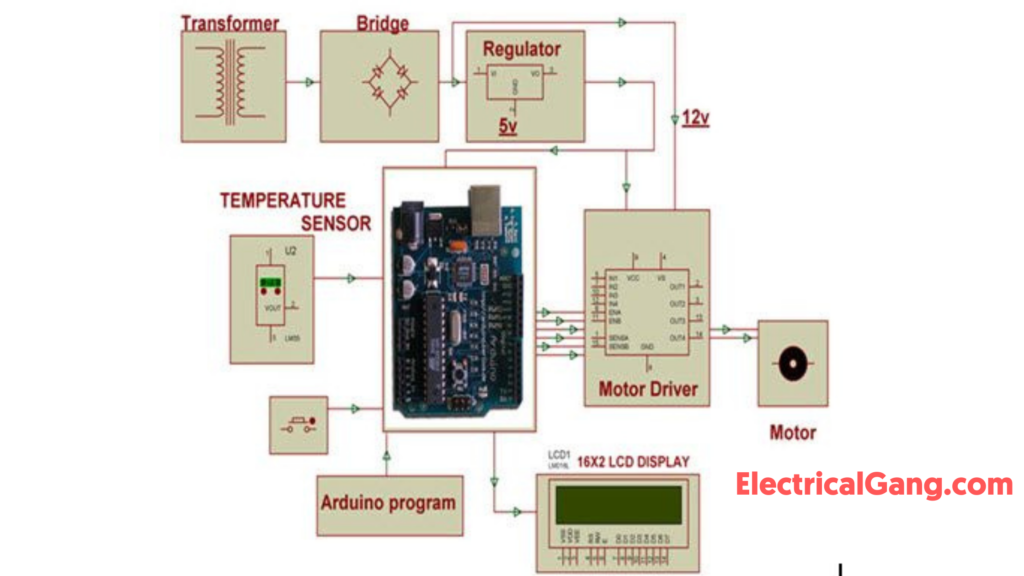
Let us understand the practical use of a temperature transducer with an example that is used to control the temperature of any device depending on the requirement of different industrial applications. An Arduino-based automatic fan speed regulator controls the temperature and displays the measurement of temperature on the LCD display.
Settings like INC and DEC are used to increase or decrease the temperature. The pulse width modulation output depending on the temperature will be generated by the program of an Arduino board. Its output is used to control the DC fan through the motor driver IC.
Suggested Read: How to Reset Roku TV Without Remote in Just Few Steps
#3. Piezoelectric Transducer:
Piezoelectric Transducer is a special type of transducer. The main function of this transducer is to convert mechanical energy into electrical energy. In the same way, electrical energy can be converted into mechanical energy.
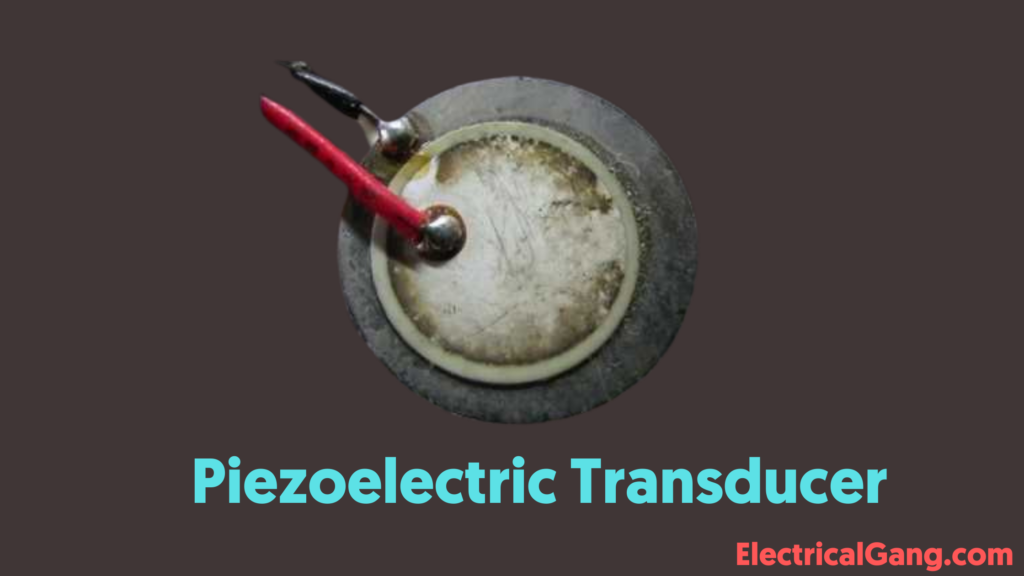
Piezoelectric Transducer Applications:
- This transducer is used as a nozzle sensor in automotive engine systems. So that the knock of the engine can be seen.
- The main use of this transducer is to know the effect of the stick drummer on the electronic drum pad. And is also used to detect muscle movement in the body, which can be called acceleromerography.
#4. Pressure Transducer:
A pressure Transducer is also a special type of sensor like a Piezoelectric Transducer. Which converts the pressure into the pressure of the electrical signal. These transducers are also called pressure indicators, piezometers, manometers, transmitters, and pressure sensors.

Application of Pressure Transducer:
This transducer is used to measure the pressure of a quantity of gas or liquid by converting the pressure into electrical energy. These are different types of transducers such as amplified voltage transducers, strain-gauge base pressure transducers, millivolt (MV) transducers, and pressure transducers.
Suggested Read: What is a Biosensor? | Types of Biosensor
Classification of Transducer Types:
There are different methods for classifying transducers. But the transducer is not restricted to the function of the constitution otherwise the occurrence of their function. It is very easy to classify transducers as input and output transducers, but it is considered a simple signal converter. The main function of the input transducer is to gauge the quantity from electrical to non-electrical.
The work of the output transducer, on the other hand, is quite different as it has an electrical input signal. While there are no signs like electrical displacement, force, pressure, torque, etc. The transducers of the principle of operation can be classified into three types electrical, thermal, and mechanical.
| Sr. No. | Classification of Transducer Types |
| #1. | Physical Effect |
| #2. | Physical Quantity |
| #3. | Source of Energy |
| #4. | Principle of Transduction |
| #5. | Primary & Secondary Transducer |
| #6. | Analog & Digital Transducer |
| #7. | Transducer & Inverse Transducer |
#1. Physical Effect:
The first classification of transistors can be based on the influence of the body. This is the first classification of transducers that rely on physical performance. It is used for everything from physical to electrical. For example, the change in the copper element inside the resistance will be proportional to the change in temperature. Here are the physiological effects used for changes in resistance, inductance, capacitances, Hall effect, and piezoelectric effect.
#2. Physical Quantity:
The second classification of transducers depends on the changing physical quantity. Which is the last use of the transducer behind the conversion. A pressure transducer, for example, is a transducer that converts pressure into an electrical signal. The classification of transducers on the basis of physical quantity includes the following
- Thermocouple-like temperature transducer.
- Bordon gauge-like pressure transducer.
- Torque tube-like level transducer.
- A flow transducer is like a flow meter.
- Push the transducer like a dynamometer.
#3. Source of Energy:
Source of Energy
Depending on the source of energy the transducer can be classified into two parts which are as follows:
- Active Transducers.
- Passive Transducers.
#3.1 Active Transducers:
In this type of transducer, the input energy is used as a control signal while transmitting energy using the power supply to the proportional output.
For example, in an active transducer like a strain gauge, the strain can be turned into resistance. However, since the stress energy is low, the energy for the output can be supplied by an external power supply.
#3.2 Passive Transducers:
In this type of transducer, the input energy can be converted to direct output energy. Passive transducers, such as thermocouples, for example, can be converted into voltage or electrical signals wherever heat energy from the input can be absorbed.
#4. Principle of Transduction:
A transducer can be classified based on the means of transduction. The medium here can be inductive depending on the capacitive, resistive, or conversion method and how the input transducer converts the input signal into resistance, induction, and capacitance respectively.
#5. Primary & Secondary Transducer:
Primary transducers include electrical and mechanical devices. The mechanical device is also known as the primary transducer. Which is used to convert a physical input quantity into a mechanical signal. The main function of the second transducer is to convert the signal from mechanical to electrical. The intensity of the output signal depends mainly on the input mechanical signal.
#6. Analog & Digital Transducer:
The transducer can be classified on the basis of its output signal. Which is constantly different otherwise.
The main function of an analog transducer is to convert the amount of input into continuous operation. Excellent example of an analog transducer is LVDT, thermocouple, strain gauge, and thermistor. A Digital transducer is used to convert the amount of input to a digital signal. Which works on low or high powers.
Digital transducers are used to measure physical quantities. So that the data can be transmitted like a digital signal coded by constantly changing voltages or currents. Types of digital transducers are shaft encoders, digital resolvers, digital tachometers, hall effect sensors, limit switches, etc.
#7. Transducer & Inverse Transducer:
Transducer: A device that can convert a non-electrical quantity into an electric quantity is called a transducer.
Inverse Transducer: Transducers that can convert electrical current into physical quantity are known as Inverse Transducers. This transducer has a high electrical input supply and low non-electrical output.
Suggested Read: Biometric Sensor | Types of Biometric Sensor
Strain Gauge Transducer:
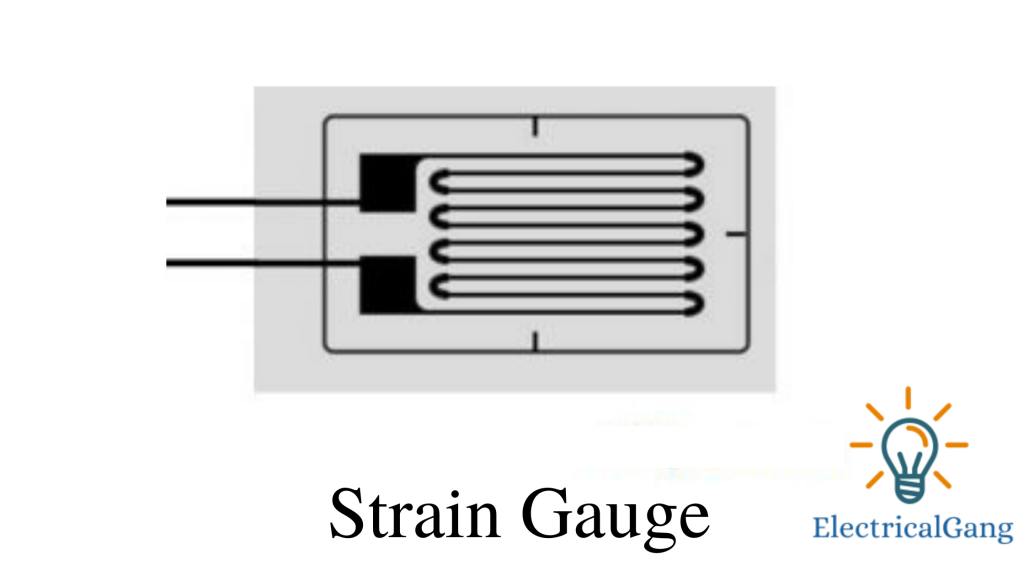
Strain Gauge Transducer The main function is to convert physical quantity into electrical quantity. In it, the component known as the sensing element works by changing the physical quantity in mechanical pressure. It then converts stress into electrical with the help of a Strain Gauge.
The design of sensing element is well designed to give tension gauges, handling, and better accuracy to the products. The use of these transducers is generally classified based on their application to civil engineering types or general types. Common types of transducers are used in construction. The types of strain gauge transducers are wire strain gauge, foil strain gauge, and semiconductor strain gauge.
Transducer Types Applications:
Transducer Types Applications are as follows:
- The transducer type is used in electrochemical experiments like the oxygen sensor, pH meter, and hydrogen sensor.
- The transducer type is also used in electroacoustic applications such as speakers, microphones, ultrasonic transceivers, piezoelectric crystals, sonar, etc.
- The transducer type is also used in thermoelectric applications such as thermistors, thermocouples, and resistance temperature detectors (RTDs).
- Transducer types are used in radio acoustic applications such as Geiger-Muller Tube, radio transmitters, and receivers.
- The transducer type is also used in photoelectric applications such as LEDs, photodiodes, photoelectric cells, LDRs, laser diodes, fluorescent, incandescent lamps, and phototransistors.
- The transducer type is also used in electromechanical applications such as accelerometers, LVDT, pressure sensors, load cells, MEMS, potentiometers, galvanometers, airflow sensors, and linear & rotary motors.
- The transducer type is also used in electromagnetic applications such as antennas, hall-effect sensors, magnetic cartridges, and disk read & writes heads.
Like this post? Could you share it with your friends?
Suggested Read –